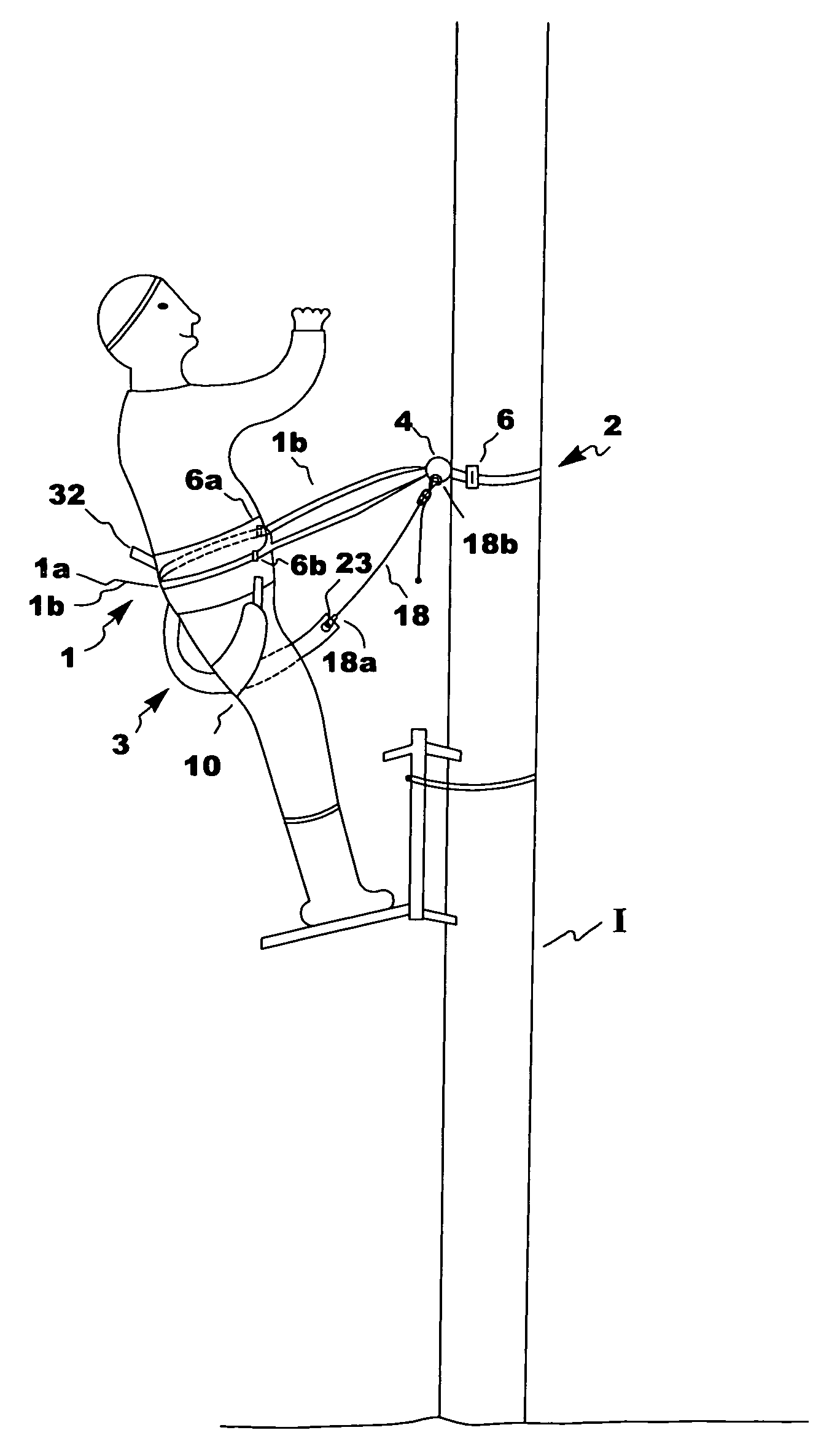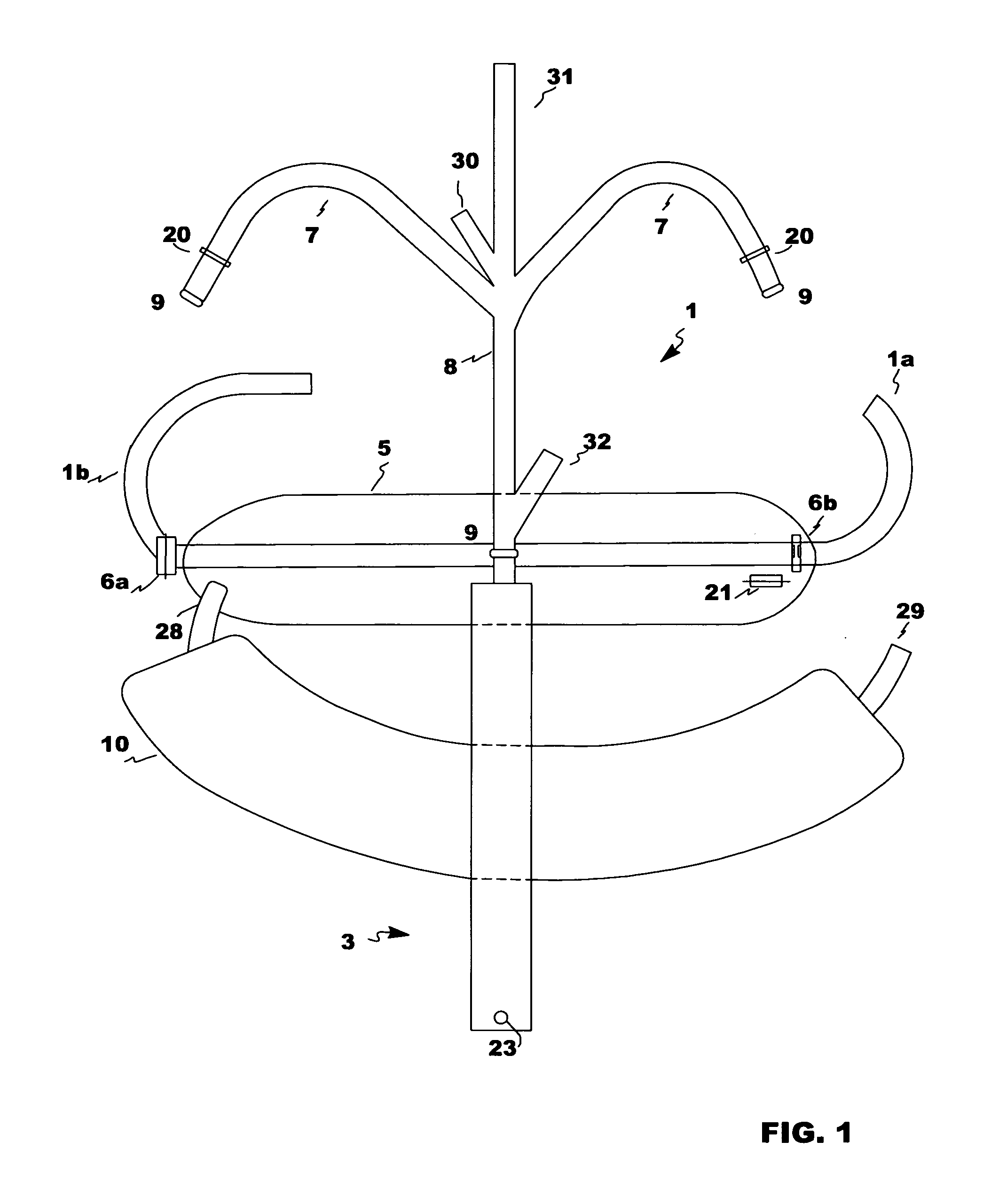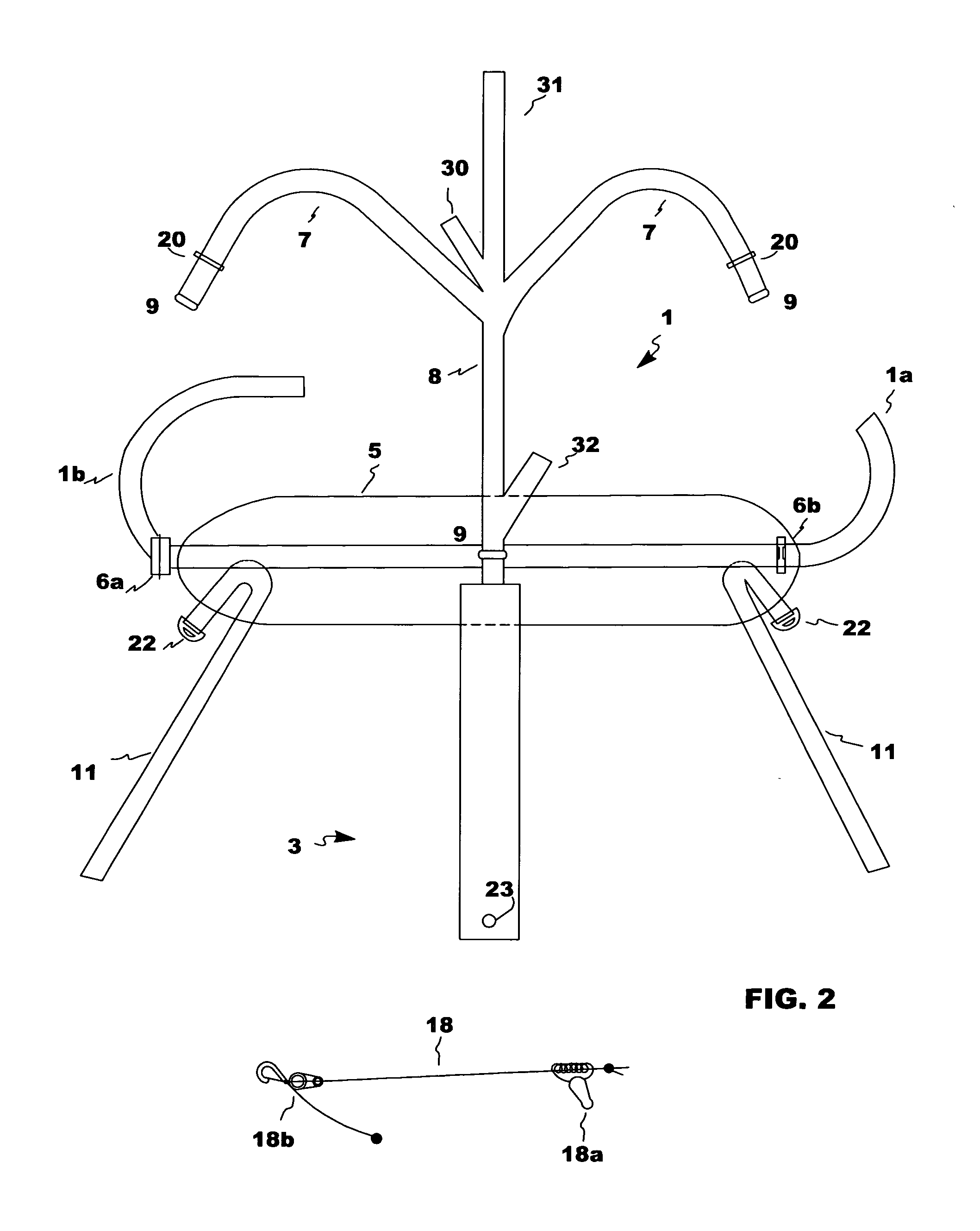[0013]The anchor member (2) is connected to a tree or other suitable object. The anchor member (2) strap is generally 1 to 4 inches wide, and attached thereto is a round or oval ring approximately 3-5″ (4) in
diameter and a D-ring (13) is attached approximately 3.5″ from the round or oval ring (4). The strap has a buckle on one end and on the opposite end it has a round
metal grommet about 1″ from the end. The 3″ round / oval ring and D-ring are attached / sewn in such a manner that the strap first goes through the rings and then approximately 12-15″ of the strap is threaded through a buckling means. This 12-15″ of strap is then doubled through the buckle and is sewn with approximately a 2-4″ opening that starts approximately 4″ from end of buckle that the 3″ round ring is contained therein. The ring / rings are sewn such that the ring / rings are pulling against the main strap and not the 15″ sewn portion. The D-ring is sewn with a very tight opening to fit the D-ring so it cannot slide. By having the round ring sewn directly to the strap in this manner, there is only a 3″ opening or so, which does not allow the ring to slide freely on the main strap. See FIG. 6. By having an approximate 3″ opening, which contains the round ring mentioned above does two things. First it allows the user safe motion from side to side. If this 3″ opening was not there and the ring was allowed to slide freely along the strap as the user moved side to side the user could loose their balance and fall. In the hunting world this opening allows safe side to side or up and down movement but without
noise. If this round ring was sewn tightly on each side to the strap, as it pivoted to the left or right as the hunter moved it would create
noise as it rubs against the sides of the strap it was sewn to. By using a 3″ round ring you also get smooth and quiet movement at all times. You could use a D-ring but with a D-ring sewn in this manner you could run into problems. As you get tension against the D-ring the strap at times folds over itself in the sharp bends of the D-ring causing
noise for a hunter and a potential safety factory for the user as wear on the strap the ring is attached to may start as they rub against each other more and more. Accordingly, a round or substantially round ring sewn to a main strap or belt in this manner is a better choice than a D-ring, in this application, although one could use a D-ring if necessary. It allows for a smooth, quiet and
safe operation. In the hunting world anything that operates smooth, quiet and safe is something that the hunter is always looking for.
[0016]The user member is generally a belt type
fastener which has two separate main straps or
webbing approximately 2″ wide, which are attached to a wider foam
waist belt. One strap approximately 64″ long is attached to user member foam
waist belt and goes around the
waist of the user and is attached by means of a buckle or 3 bar slide that is attached to the side of user member foam waist belt, which will allow for adjustment. The second strap is another approximately 2″ wide and 74″ long piece of strap or
webbing that is attached also to the foam waist belt. This second strap runs from one side of the waist belt and across the users back to the other side, then the strap runs through the 3″ round ring on anchor member that is attached to the tree or pole and is then threaded through a buckle or 3 bar slide which is attached to the side of the user member waist belt. This will allow the user to make the
proper length adjustment as compared to the size platform or device that the user is standing on. The user can now lean back against the foam waist belt, which should be a minimum of 4-6″ wide but can be wider. With this belt now around the user's waist and through the round ring to support the user the user can now move from side to side or up and down in a smooth, quiet motion not worrying about the strap making noise as he or she moves. This design will now allow for safe and controlled movement as the user moves from side to side. As you can see if the round ring was allowed to slide freely on the main strap around the tree or pole as the user leaned or moved from side to side he or she could be thrown from the pole or tree. This design creates a V shape as the belt goes around the user's waist and hip area and through the round ring, allowing for smooth, quiet and
safe operation. This user member has a 4-10″ tether located in the center of the waist belt, for safety reasons. An
advantage of having a large round ring attached to the anchor member strap is in event that the user fell from the device or platform he or she was standing on the larger round ring would allow the user a place to grab and pull them self up. This round ring would also allow a place to attach the connecting member to in case of a fall. In some cases this may actually save the users life in that it allows the user to avoid suspension trauma by pulling themselves up thus relieving the pressure put around there legs from the leg straps on most harnesses today.
[0018]The user member could also have optional shoulder straps with tethers attached which could allow the harness to be worn as a 6 point safety harness also, if so desired. The tethers and shoulder straps would be approximately 2″ wide
webbing which would be attached to the user member waist strap and or waist belt. This could be done by open loops on all ends and by using a buckle / 3 bar slide for adjustment. In one embodiment there are two tethers where in the first tether is a traditional tether, which is approximately 24″ long, from where the shoulder straps separate. This tether is where the strap that would connect the harness to the tree or pole would be connected. There would also be a second shorter tether 5-12″ long, which would be used for safety reasons. In case of a fall by having a length of
rope with a connecting means on each end such as a carabiner and prusik knot on one end attached to the short tether and on the other end a snap hook or carabiner connected to a small
pulley hoist which then could be connected to the anchor members round ring or D-ring. The user could now pull themselves up which would prevent the user from dying of suspension trauma.
[0019]The connecting member is a separate strap approximately 3-6″ wide and approximately 30″ long that is optionally wider in the middle, with one end attached in the middle of the waist belt and or waist strap. This could be attached to the front or back side of waist strap. Said strap may also have an optional D-ring attached also. At the other end of the strap is a round
metal grommet located in the middle of the strap and approximately 1″ from the end of the strap. Attached to this
metal grommet is a cord, or
rope that is approximately 3-6′ long or longer. Attached at one end of this
rope is a
pulley hoist with a connecting means such as carabiner or snap hook connected to the D-ring or round ring that is attached to anchor member and the other end has an adjustable knot, such as a Prusik knot with a carabiner attached to a round grommet at the end of the connecting member. With the connecting member attached in this manner it can act as a seat and possibly prevent a fall. In case of a fall, if the connecting member was not already attached to anchor member before the fall, given the
proper length of rope and with the connecting devises mentioned previous the rope could be run through the users legs or around both legs and connected to the round ring or D-ring which are connected to the anchor member, which is attached to a tree or pole. Once this connecting member strap is attached to the anchor members round ring or D-ring the user can then pull the rope through the
pulley and carabiner
system (pulley hoist) or prusik knot. By pulling them self up in this manner this connecting member strap will help cradle the user into more of a seated position. By being able to use the connecting member and anchor member in this manner would again help prevent the user from dying from suspension trauma if they fell from the platform they were standing on.
[0020]One of the major problems today with many of the harnesses sold in the market is that if the user were to fall from a treestand, the harness might initially save the users life by preventing the user from falling to the ground, but if the user has no means to pull him / her self up, they could die from suspension trauma in as little as 30 minutes. With the design of the present invention, this would not happen in that the user has several possibilities to pull them self up. More particularly, a major
advantage of the design of the present invention compared to many other designs is that in the case of a fall, the risks of dying from suspension trauma are greatly reduced. With the present design when used properly the user would not fall straight down and hang from your harness; rather, the user would fall forward into the tree or pole, thereby facing the tree or pole in a somewhat seated position. With the round ring to grab hold of and help pull yourself up to situate your weight the user now can shift his or her weight around and sit in the harness until help arrives. If used properly the connecting member used in conjunction with the anchor member as stated above could be used as an accessory to many of the harnesses on the market today. These 2 members could help prevent death's that are occurring today from suspension trauma when a user falls from the platform they were standing on.
 Login to View More
Login to View More  Login to View More
Login to View More 


